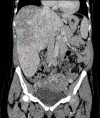Anaesthetic management for caesarean section in a patient with hereditary haemorrhagic telangiectasia and severe epistaxis during pregnancy
- PMID: 37788916
- PMCID: PMC10551871
- DOI: 10.1136/bcr-2023-255530
Anaesthetic management for caesarean section in a patient with hereditary haemorrhagic telangiectasia and severe epistaxis during pregnancy
Abstract
A primigravida patient, with a history of hereditary haemorrhagic telangiectasia (HHT) manifesting as nasal angiodysplasia and hepatic arteriovenous malformations (AVM), presented for delivery planning and anaesthetic evaluation at 29 weeks of gestation. She was hospitalised several times during the second and third trimester for serious recurrent epistaxis, leading to severe anaemia. In total, she required the transfusion of 20 units of packed red blood cells during her pregnancy as well as surgical nasal haemostasis under general anaesthesia (GA). The patient was referred to our tertiary centre for delivery. In the context of recurrent severe epistaxis and high cardiac output (due to hepatic AVM) in the third trimester, a multidisciplinary decision was made to plan an elective caesarean section at 35 4/7 weeks combined with nasal packing under GA. This report discusses the implications of HHT, the multidisciplinary planning of the caesarean section, intraoperative anaesthetic management and patient follow-up.
Keywords: Anaesthesia; Ear, nose and throat/otolaryngology; Haematology (incl blood transfusion); Pregnancy.
© BMJ Publishing Group Limited 2023. Re-use permitted under CC BY-NC. No commercial re-use. See rights and permissions. Published by BMJ.
Conflict of interest statement
Competing interests: None declared.
Figures


Similar articles
-
Anaesthetic management of a parturient with hereditary haemorrhagic telangiectasia (HHT) and pulmonary haemorrhage requiring urgent caesarean section.BMJ Case Rep. 2020 Jan 13;13(1):e231120. doi: 10.1136/bcr-2019-231120. BMJ Case Rep. 2020. PMID: 31937626 Free PMC article.
-
Anaesthetic management of parturients with hereditary haemorrhagic telangiectasia for caesarean section.Int J Obstet Anesth. 2009 Apr;18(2):176-81. doi: 10.1016/j.ijoa.2008.12.001. Epub 2009 Feb 3. Int J Obstet Anesth. 2009. PMID: 19196506
-
Nasal closure for the treatment of epistaxis secondary to hereditary hemorrhagic telangiectasia.Acta Otorrinolaringol Esp. 2016 Nov-Dec;67(6):345-348. doi: 10.1016/j.otorri.2015.12.002. Epub 2016 Apr 11. Acta Otorrinolaringol Esp. 2016. PMID: 27079134 English, Spanish.
-
Hereditary haemorrhagic telangiectasia and pregnancy: a review of the literature.Orphanet J Rare Dis. 2020 Jan 7;15(1):5. doi: 10.1186/s13023-019-1286-z. Orphanet J Rare Dis. 2020. PMID: 31910869 Free PMC article. Review.
-
Medical management of haemorrhagic hereditary telangiectasia in adult patients.Med Clin (Barc). 2019 Apr 5;152(7):274-280. doi: 10.1016/j.medcli.2018.09.015. Epub 2018 Nov 27. Med Clin (Barc). 2019. PMID: 30502301 Review. English, Spanish.
References
-
- Sabbà C, Pasculli G, Cirulli A, et al. . Hereditary hemorrhagic teleangiectasia (Rendu-Osler-Weber disease). Minerva Cardioangiol 2002;50:221–38. - PubMed
Publication types
MeSH terms
Substances
LinkOut - more resources
Full Text Sources
Medical
